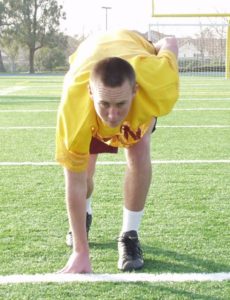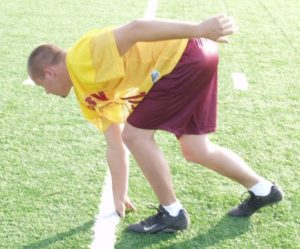SWAT Team
A kickoff is a form of defense. The “directional kick approach” is designed to control the return possibilities. However, regardless of how well the kicker executes his techniques, the key to a successful kickoff is the coverage. The reason is that no matter how well alignments are disguised, or where the ball is kicked, unless the coverage is good, the kickoff will not be successful.
As noted above, there are some approaches to coverage that use “run & read zone”, “avoidance zone” and “contact zone”. This can confuse some players, so our basic coverage philosophy is to avoid early, run through late. The technique of “avoid” is avoiding all blocks to the tail of the opponent, and then get back into your lane. This would be in the first twenty yards for Bullets, and first thirty yards for the Alleys. The technique of “run through” is to attack and play through all blocks. When defeating a block, the player cannot get caught on a side of the blocker. This opens up running lanes for the ball carrier. The players will run through, staying square.
The spacing of the coverage team in relation to the return team, along with the speed of the play, makes the kickoff the most aggressive play in football. However, even though the kickoff requires physical aggression, it also requires the players to be mentally tough and use proper technique. The teaching process includes: (1) Kicker – directional kicks, (2) Get Off – speed down the field, (2) Defeating a Blocker – adjustments to the ball, and (3) Open Field Tackling – close and tackle.
Kicker
Many coaches look for a kicker who can kick the football into the end zone – consistently. Reality check! We look for a kicker that can perform, or will work on perfecting our directional kicks. Consistency is an important element in our coverage schemes. When we can count on our kicker to kick the ball, with the acceptable hang time, to a specific location we have the advantage because we are coaching our coverage players to converge to a specific spot and adjust to the ball carrier.
Get Off
We use a “form start” five-yards behind the ball. Every player in our program knows how to get into this stance because we practice it year-round. The feet are narrow (“inside shoulders”), with a stagger of six to twelve inches. The drop hand is directly down from the shoulder, with the thumb and forefinger supporting the stance. The shoulders are aligned in front of the hand. The hips are elevated, higher than the shoulders. The back should be flat. The head is up, with the eyes focused approximately two to three feet in ahead. This stance puts the player’s body in a pushing position that allows them to accelerate very quickly. As the kicker yells “ready”, begin to count 1001, 1002 and then drive off the balls of the feet, completely extending the ankles, knees, and hips while driving the off arm to propel the start. It is this stance that allows us to align five-yards behind the ball, versus the traditional ten-yards.
Key Coaching Points:

- Place the front foot 1 to 3 inches behind the free-kick line;
- Drop the arm, opposite the front foot straight down from the shoulder;
- Place the hand (off the dropped arm) high on the fingertips right behind the free-kick line, with the thumb and forefinger parallel to the line;
- Place the other hand to the hip of the forward leg with the elbow up;

- Stagger the back foot 6 to 12 inches behind the heel of the forward (front) foot;
- Raise the hips slightly above the shoulders creating a forward lean so the shoulders are slightly ahead of the free-kick line;
- Shift the majority of the body weight onto the front leg and hand; and
- Focus the eyes 2 to 3 feet in front of the free-kick line.
Defeating a Blocker
As the coverage team closes the distance between themselves and the first wave of blockers, they must set them up so they can avoid them, and get back in their lanes by the butt of the blocker. This can be accomplished by swerving or weaving using head fakes in the run. These can begin within seven to eight yards from the blocker. The coverage player is trying to get the blocker to stop their feet, adjust their course or crossover compromising their base. As the coverage player closes the gap, they can widen their running base allowing them to go in either direction. Also, a swim or rip technique can be used. If the blocker appears to be in balance, feet stopped, then run right by him without any moves.
- Swim: Slap the blockers shoulder with the off arm, while punching the hand directly over the top of the shoulder pad.
- Rip: Reach to the back pocket (“dip” or reducing the shoulder pad surface), rub the body and club up finishing the rip by kissing the bicep. The coverage player must accelerate through the rip to get by the blocker.
If the blocker makes contact, attack him with a three-point punch. This should get him off balance, as the coverage player should be attacking with speed. Get the hands on the breastplate of the shoulder pads. Drive the blocker back into the return until you see the ball. Then use a push-pull technique, ripping off the block to make a play.
Coverage Principles
The following is a brief list of coaching points when discussing kick coverage:
- Keep the return team off balance with directional kicks.
- Kick coverage is an all-out sprint, however as important as speed, is the desire to make the tackle is more important.
- Know and execute coverage responsibilities – avoid early, run through late. Don’t overrun the ball!
- Alignments should initially defend the field, but once the return has been defined, defense the football.
- It is not a shame to get knocked down, but it is a crime to stay down.
- Locate the ball and converge.
- Maintain an inside shoulder relationship (outside leverage) with the ball carrier and attack him aggressively.
- If you lose your outside leverage on the ball carrier, come to balance as you get to the breaking point in front of the ball carrier in order to make the tackle. Make sure your body is under control, moving your feet in a good football position.
- Wedge defender, or first man approaching the wedge should:
- Use up two blockers by attacking a gap between them keeping the pad level low; and
- Force the ball carrier to move laterally.
- The first man down very seldom makes the tackle so keep coming because he has set the ball carrier up for the hit.
- Create a fumble by striking up through the ball, or if the second man to the ball carrier, strip or rip the football, thinking turnover.
- Be alert to recover the football anywhere on the field.
- Gang tackling sends a physical message to your opponent. Keep attacking until the whistle blows.
- All kickoffs must be covered! Do not anticipate the official’s whistle. Go all out until the whistle blows.
About the Author of this post:
Jerry Campbell has over 30 years of high school and college coaching experience. He has experience as a head coach, offensive coordinator, and various position coaches. He has written numerous football coaching articles in various publications, is the author of over 30 books on coaching football, and has produced 12 coaching video series. Additionally, he is a nationally sought after speaker on the coaching clinic circuit.